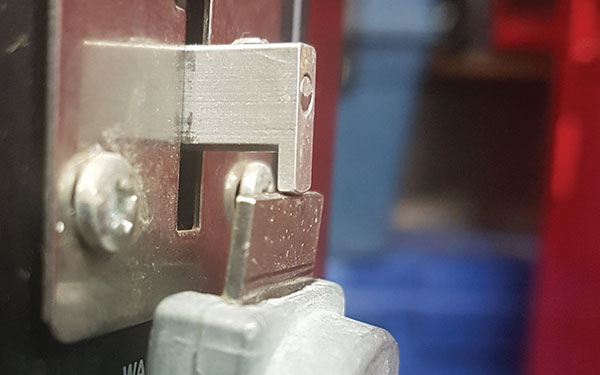

If you’re looking to purchase a kiln, you can often find great deals on older used models online. Most older kilns use kiln sitters as the shut-off mechanism, rather than fancy computer controllers. In today’s Quick Tip, Sue McLeod shares how to easily calibrate and maintain your kiln sitter to get the best results from every firing. –Jennifer Poellot Harnetty, editor
Manual kilns have switches for turning up the heat and they have a nifty contraption called a kiln sitter that uses a melting, bending pyrometric cone to shut the kiln off at a specific temperature.
Kiln sitters are designed for use with a small sitter cone that’s propped onto two metal cone supports inside the kiln with a sensing rod laying over the center of the cone. The sensing rod extends from the inside of the kiln to the outside, and is mounted so that it can pivot up and down like a seesaw. On the outside, there’s a metal, L-shaped claw on the end that holds a weighted latching mechanism in place (1). When the latch is up and being held by the claw, the kiln can be turned on.
As the kiln approaches its target temperature, the cone in the kiln sitter will soften and the weight of the sensing rod will cause the cone to bend (2). As the sensing rod sinks down into the cone, the claw on the outside rises, releasing the latching mechanism, which falls down and shuts the kiln off.


How to Know if Your Kiln Sitter Needs Calibrating
The kiln sitter is designed so that when the kiln reaches the target cone temperature, the kiln shuts off. When the kiln shuts off, a larger, pyrometric witness cone of the same number should be fully bent as well. So, when you put witness cones in your cone-6 firing, the tip of cone 6 should be bent over and pointing down toward the kiln shelf when the kiln shuts off (3). If your witness cones don’t look perfect when your kiln shuts off, your sitter needs to be adjusted. Always trust large witness cones over small sitter cones.
Any time I get a new kiln or perform any maintenance on a kiln, or if my firings aren’t completely perfect, the first thing I do is re-calibrate my kiln sitter. It only takes a minute!
What You Need to Calibrate Your Kiln Sitter
- A device called a firing gauge (4). You should be able to get one at any ceramic supplier.
- A tiny screwdriver for the set screw that holds the trigger plate (on the latching mechanism) in place.
- A pencil to mark the height where your trigger plate started.

How to Calibrate Your Kiln Sitter
Begin by sliding the firing gauge over the sensing rod and cone supports. The sensing rod goes through the hole in the center and the cone supports go through the slotted grooves in the sides. This places the sensing rod at the same angle that it would be if the small sitter cone was perfectly bent at a 90° angle. When the rod is at this angle, the latch should be ready to fall.
With the firing gauge in place, swing the latch upward and see where the top of the trigger plate comes to in relation to the bottom of the claw. Is there a gap between the bottom of the claw and the top of the trigger plate? Does the plate move snugly past the claw? Or does the claw block the plate from moving past?
You want the trigger plate to come into contact with the claw, with no gap in between. It shouldn’t be so high that it can’t move past the claw, nor should it be so low that it moves by without touching the claw. They should brush against each other. If that’s the case, then your kiln sitter is calibrated. If the trigger plate is too high or too low, it needs to be adjusted.
I always mark the trigger plate with a pencil before I make any adjustments (5), so I know what level it started at. This way, if I move it too far, I can see where it was before adjusting. Draw a line across the trigger plate where it meets the latching mechanism that holds it.


Loosen the set screw so the trigger plate will slide up and down. Adjust the plate so that it just touches the bottom of the claw and then tighten the screw. Remove the firing gauge before firing the kiln.
Don’t forget to always use witness cones inside the kiln and check to make sure the sitter falls at the right time. If the kiln shuts off early, move the trigger plate up slightly for the next firing. If it shuts off late, move the trigger plate down slightly for the next firing. A worn-down sensing rod can throw off the calibration, so small adjustments may be needed before it’s perfect.
And that’s it! That’s all it takes to calibrate your kiln sitter.
The Author: Sue McLeod is a potter and studio technician in Victoria, British Columbia, Canada. She teaches online glaze classes and writes articles about glazes and studio tips on her blog at www.suemcleodceramics.com.






